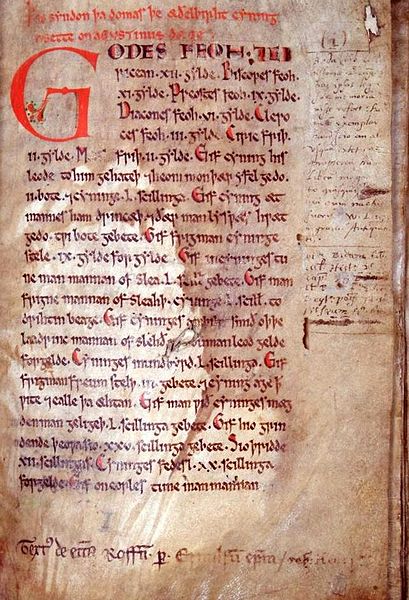As a graded Arbitrator, born a Kentish Man in the Western part of the County of Kent (UK), I was interested to read about a project to put on public display in Rochester Cathedral, the Textus Roffensis currently held in the archives at Rochester Kent.
The Textus de Ecclesia Roffensi per Ernulphum episcopum (The Book of the Church of Rochester through Bishop Ernulf), is a mediaeval manuscript that consists of two separate manuscripts that were written between 1122 and 1124, some 60 years after the Norman conquest of 1066. One part is the legal records of the Church.
From a legal perspective, the interesting part is a recording of the Saxon legal codes used in the Kingdom of Kent prior to the Norman invasion:
- The Law of Æthelberht is a set of legal provisions written in Old English, probably dating to the early 7th century. It originates in the kingdom of Kent, and is the first Germanic-language law code. It is also thought to be the earliest example of a document written in English.
- The Law of Hlothhere and Eadric is an Anglo-Saxon legal text. It is attributed to the Kentish kings Hloþhere (died 685) and Eadric (died 686), and thus is believed to date to the second half of the 7th century. Law of Hlothhere and Eadric has more focus on legal procedure and has no religious content
- The Law of Wihtred is an early 8th-century code, written in language more modernised than the earlier codes and focuses on the rights of the Church (following the introduction of Christianity to Saxon England).
Provision 6 in the Law of Law of Hlothhere and Eadric is important to the understanding of the Anglo-Saxon arbitration process. A person, once accused, must take an oath promising to abide by the decision of a judge or accept a fine of 12 shillings. The accuser and accused must try to seek out an arbitrator acceptable to both. Once the judgment is delivered, the one ruled against must make good to the other, or swear on oath that he is innocent. If the accused refuses to co-operate, he is liable to a fine of 100 shillings – a freeman’s wergild – and forbidden to swear his innocence in future.
This Law is also important for showing that the Kentish kingdom had control of London in the late 7th century. Provision 11 rules that Kentish men buying property in London must do so in public in the presence of two or three freemen of good standing or else before the king’s wicgerefan, port-reeve. A predecessor of these kings, Eadbald son of Æthelberht (died 640), had issued a coin in London earlier in the 7th century.
The Saxon approach to law was focused on restoring the rights of an injured party through arbitration, based on the consent of the people (not Royal Decree); these same principles of fairness and justice re-surfaced in the Magna Carta some 100 years later in 1215 when the Barons reclaimed the rights of the people to a fair trial and limited the arbitrary discretion of the Crown. Magna Carta is based on the laws recorded in the Textus Roffensis making the Textus Roffensis a more significant if less well known document.
From a modern perspective, apart from the ability to ‘swear an oath of innocence’ the concept of Arbitration detailed in the Law of Hlothhere and Eadric is remarkably similar to modern Arbitration provisions. It is a pity that such an effective dispute resolution process is little used and frequently resembles a court process rather than a practical dispute solving system.


